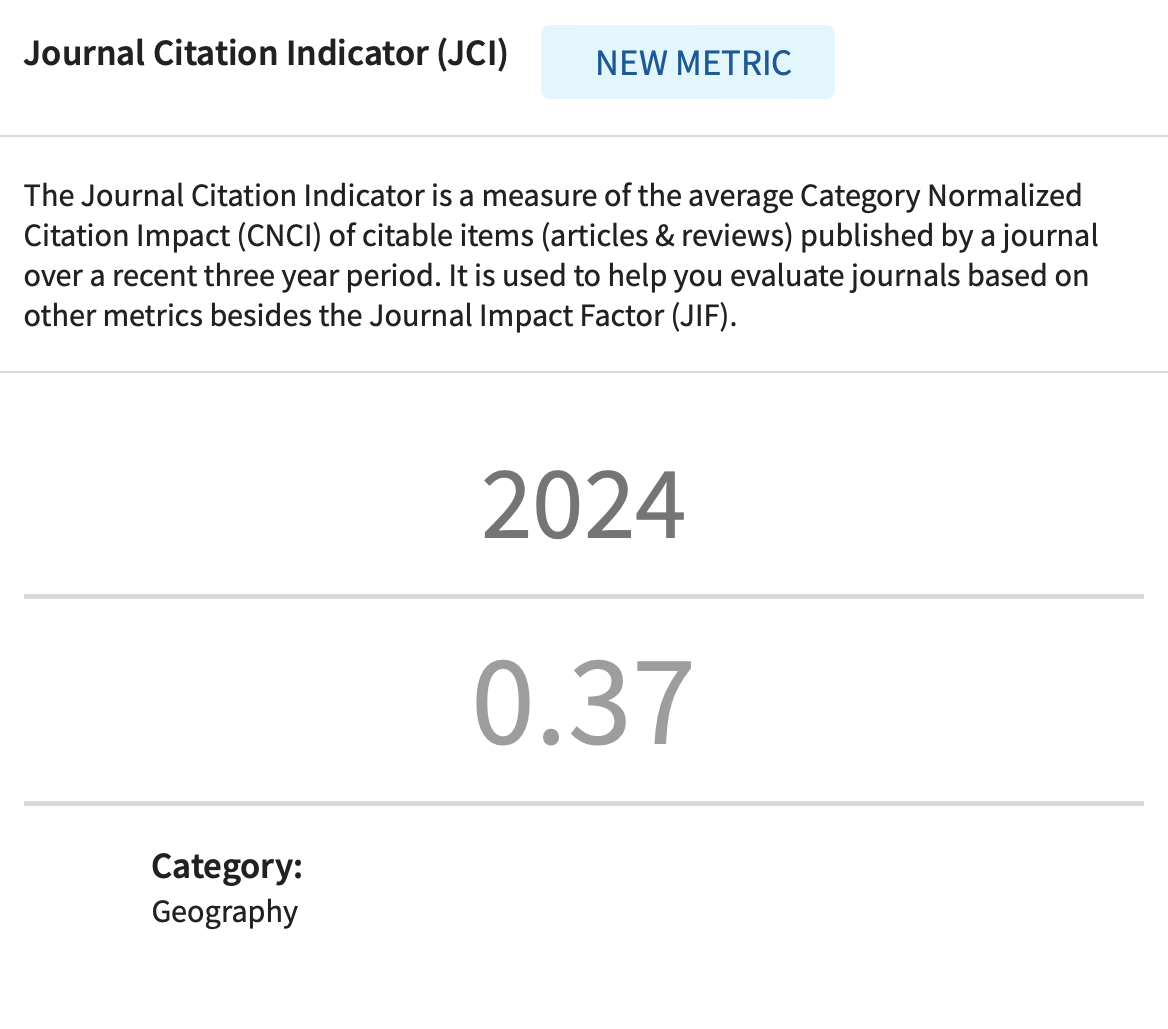IDENTIFICATION OF SMALL LAKES IN KAZAKHSTAN USING REMOTE SENSING DATA
DOI:
https://doi.org/10.2298/IJGI241025005TKeywords:
surface water, small lakes, remote sensing data, Sentinel-2, KazakhstanAbstract
The purpose of this study is to develop a methodology for automated determination of water surfaces and identification of small lakes in Kazakhstan using cartographic methods and an array of multi-time remote sensing (RS) data. The methodology involved automated surface water classification using multi-temporal Sentinel-2 satellite imagery (spanning the period 2016–2021, focusing on the warm months from May to September), Python-based processing on the Google Earth Engine platform, geographic information system (GIS) based morphometric analysis, and field validation to accurately identify and characterize small lakes in Kazakhstan. The study applied the Normalized Difference Water Index (NDWI), Modified Normalized Difference Water Index (MNDWI), and Normalized Difference Vegetation Index (NDVI) to enhance surface water detection, reduce noise from vegetation, and improve the accuracy of lake boundary delineation from multi-temporal Sentinel-2 imagery. A technique for automated extraction of morphometric characteristics of small lakes has been developed, data on lake morphometry have been obtained. Verification against field measurements demonstrated a high degree of accuracy, with relative error rates of 12% for lake lengths and 13% for the widths. However, challenges such as dense vegetation, high salinity, and the color of shallow lake bottoms led to some classification errors, highlighting the need for further refinement of automated algorithms. As a result, a list of small lakes in Kazakhstan with a surface area from 1 to 10 km2 was identified.
Article metrics
References
Abiyeva, D. K., Karagulova, R. K., Ayupov, K. A., Tolepbayeva, A. K., & Urazbayeva, G. M. (2020). Analysis of suitability of global surface water data sets for studying the dynamics of the lake areas in Kazakhstan. Issues of Geography and Geoecology, 3, 33–42.
Abiyeva, D. K., Karagulova, P. K., Nysanbaeva, A. S., Abayev, N. N., Urazbayeva, G. M., Radusnova, O. V., Sharapkhanova, Z. M., & Tolepbayeva, A. K. (2021). Geospatial web application to support climate change research in Kazakhstan. InterCarto InterGIS, 27, 108–119. https://doi.org/10.35595/2414-9179-2021-3-27-108-119
Albarqouni, M. M. Y., Yagmur, N., Bektas Balcik, F., & Sekertekin, A. (2022). Assessment of Spatio-Temporal Changes in Water Surface Extents and Lake Surface Temperatures Using Google Earth Engine for Lakes Region, Türkiye. ISPRS International Journal of Geo-Information, 11(7), Article 407. https://doi.org/10.3390/ijgi11070407
Amani, M., Kakooei, M., Ghorbanian, A., Warren, R., Mahdavi, S., Brisco, B., Moghimi, A., Bourgeau-Chavez, L., Toure, S., Paudel, A., Sulaiman, A., & Post, R. (2022). Forty Years of Wetland Status and Trends Analyses in the Great Lakes Using Landsat Archive Imagery and Google Earth Engine. Remote Sensing, 14(15), Article 3778. https://doi.org/10.3390/rs14153778
Annenkov, A., Medvedskyi, Y., Demianenko, R., Adamenko, O., & Soroka, V. (2023). Preliminary accuracy assessment of low-cost UAV data processing results. International Conference of Young Professionals "GeoTerrace 2023", 2023, 1–5. Lviv, Ukraine. https://doi.org/10.3997/2214-4609.2023510014
Bai, B., Mu, L., & Tan, Y. (2025). A Global Lakes/Reservoirs Surface Extent Dataset (GLRSED): An integration of multi-source data. Geoscience Data Journal, 12(1), Article e285. https://doi.org/10.1002/gdj3.285
Chai, T., & Draxler, R. R. (2014). Root mean square error (RMSE) or mean absolute error (MAE)? – Arguments against avoiding RMSE in the literature. Geoscientific Model Development Discussions, 7, 1247–1250. http://dx.doi.org/10.5194/gmdd-7-1525-2014
Cole, N. S. (1981). Bias in testing. American Psychologist, 36(10), 1067–1077. https://doi.org/10.1037/0003-066X.36.10.1067
Copernicus: Sentinel-2. (2023). https://directory.eoportal.org/web/eoportal/satellite-missions/c-missions/copernicus-sentinel-2
Dyldaev, M., Chymyrov, A., Mukabaev, A., & Omurzak Uulu, O. (2021). Investigation of the population area of snow leopard in the Central Tian-Shan Mountains. E3S Web of Conferences, 227, Article 02002. https://doi.org/10.1051/e3sconf/202122702002
Fedoniuk, T. P., & Skydan, O. V. (2023). Incorporating geographic information technologies into a framework for biological diversity conservation and preventing biological threats to landscapes. Space Science and Technology, 29(2), 10–21. https://doi.org/10.15407/knit2023.02.010
Fedonyuk, T. P., Galushchenko, O. M., Melnichuk, T. V., Zhukov, O. V., Vishnevskiy, D. O., Zymaroieva, A. A., & Hurelia, V. V. (2020). Prospects and main aspects of the GIS-technologies application for monitoring of biodiversity (on the example of the Chornobyl Radiation-Ecological Biosphere Reserve). Space Science and Technology, 26(6), 75–93. https://doi.org/10.15407/knit2020.06.075
Fiona. (n.d.). Fiona (Version 1.8.18) [Computer Software]. https://pypi.org/project/fiona/
Gao, B. (1996). NDWI – A normalized difference water index for remote sensing of vegetation liquid water from space. Remote Sensing of Environment, 58(3), 257–266. https://doi.org/10.1016/S0034-4257(96)00067-3
Global Surface Water Explorer. (2025). https://global-surface-water.appspot.com/
Google Erath Engine API. (n.d.). https://developers.google.com/earth-engine/reference/rest
Gourgouletis, N., & Baltas, E. (2023). Investigating Hydroclimatic Variables Trends on the Natural Lakes of Western Greece Using Earth Observation Data. Sensors, 23(4), Article 2056. https://doi.org/10.3390/s23042056
Han, Q., & Niu, Z. (2020). Construction of the Long-Term Global Surface Water Extent Dataset Based on Water-NDVI Spatio-Temporal Parameter Set. Remote Sensing, 12(17), Article 2675. https://doi.org/10.3390/rs12172675
Hierarchical Clustering in Machine Learning. (2025). https://www.geeksforgeeks.org/hierarchical-clustering/
Jin-Ming, Y., Li-Gang, M., Cheng-Zhi, L., Yang, L., Jian-li, D., & Sheng-Tian, Y. (2019). Temporal-spatial variations and influencing factors of Lakes in inland arid areas from 2000 to 2017: a case study in Xinjiang. Geomatics, Natural Hazards and Risk, 10(1), 519–543. https://doi.org/10.1080/19475705.2018.1531942
Karches, T. (2023). Towards a Dynamic Compartmental Model of a Lamellar Settler. Symmetry, 15(4), Article 864. https://doi.org/10.3390/sym15040864
Latipov, N. F. O., & Komilova, N. K. (2024). The Importance of Anthropogenic Influence in Assessing the Ecological Condition of Cities in Uzbekistan (in the Case of Navoi). Baghdad Science Journal, 21(4), 1214–1219. https://doi.org/10.21123/bsj.2023.8892
Li, B., Zhang, Y.-C., Wang, P., Du, C.-Y., & Yu, J.-J. (2019). Estimating Dynamics of Terminal Lakes in the Second Largest Endorheic River Basin of Northwestern China from 2000 to 2017 with Landsat Imagery. Remote Sensing, 11(10), Article 1164. https://doi.org/10.3390/rs11101164
Li, M., Hong, L., Guo, J., & Zhu, A. (2022). Automated Extraction of Lake Water Bodies in Complex Geographical Environments by Fusing Sentinel-1/2 Data. Water, 14(1), Article 30. https://doi.org/10.3390/w14010030
Liao, P. S., Chen, T. S., & Chung, P. C. (2001). A Fast Algorithm for Multilevel Thresholding. Journal of Information Science and Engineering, 17(5), 713–727. https://doi.org/10.6688/JISE.2001.17.5.1
Little, S., Pavelsky, T. M., Hossain, F., Ghafoor, S., Parkins, G. M., Yelton, S. K., Rodgers, M., Yang, X., Crétaux, J.-F., Hein, C., Ullah, M. A., Lina, D. H., Thiede, H., Kelly, D., Wilson, D., & Topp, S. N. (2021). Monitoring Variations in Lake Water Storage with Satellite Imagery and Citizen Science. Water, 13(7), Article 949. https://doi.org/10.3390/w13070949
Manilyuk, T. L., & Maslova, L. V. (2017). The Research of Water Surfaces of Lakes by Applying of Water Index Based on the Remote Sensing Data. Transbaikal State University Journal, 23(3), 4–11. https://www.researchgate.net/publication/319468079_The_Research_of_Water_Surfaces_of_Lakes_by_Applying_of_Water_Index_Based_on_the_Remote_Sensing_Data
Mueller, N., Lewis, A., Roberts, D., Ring, S., Melrose, R., Sixsmith, J., Lymburner, L., McIntyre, A., Tan, P., Curnow, S., & Ip, A. (2016). Water observations from space: Mapping surface water from 25 years of Landsat imagery across Australia. Remote Sensing of Environment, 174, 341–352. https://doi.org/10.1016/j.rse.2015.11.003
Mustafayeva, E., & Tagiyev, A. (2023). Perspective of using groundwater in the Ganikh-Ayrichay foothills. Reliability: Theory and Applications, 18(5), 136–141. https://doi.org/10.24412/1932-2321-2023-575-136-141
Nash, J. E., & Sutcliffe, J. V. (1970). River flow forecasting through conceptual models part I – A discussion of principles. Journal of Hydrology, 10(3), 282–290. https://doi.org/10.1016/0022-1694(70)90255-6
NumPy. (n.d.). NumPy (Version 1.18) [Computer Software]. NumPy team. https://numpy.org/
Otsu, N. (1979). A Threshold Selection Method from Gray-Level Histograms. IEEE Transactions on Systems, Man, and Cybernetics, 9(1), 62–66. https://doi.org/10.1109/TSMC.1979.4310076
Peng, Y., He, G., Wang, G., & Cao, H. (2021). Surface Water Changes in Dongting Lake from 1975 to 2019 Based on Multisource Remote-Sensing Images. Remote Sensing, 13(9), Article 1827. https://doi.org/10.3390/rs13091827
Physical-geographic characteristics of the region. (n.d.). http://www.cawater-info.net/bk/water_land_resources_use/english/docs/fiziko_geog_kharack_kazakhstan.html
Python Software Foundation. (n.d.). Python (Version 3.0) [Computer Software]. Python Software Foundation. https://www.python.org/
Ratner, B. (2009). The correlation coefficient: Its values range between +1/−1, or do they? Journal of Targeting, Measurement and Analysis for Marketing, 17, 139–142. https://doi.org/10.1057/jt.2009.5
Romanchuk, L., Fedonyuk, T., Pazych, V., Fedonyuk, R., Khant, G., & Petruk, A. (2018). Assessment of the stability of aquatic ecosystems development on the basis of indicators of the macrophytes fluctuating asymmetry. Eastern-European Journal of Enterprise Technologies, 4(10(94)), 54–61. https://doi.org/10.15587/1729-4061.2018.141055
Rouse, J. W., Haas, R. H., Scheel, J. A., & Deering, D. W. (1974). Monitoring vegetation systems in the great plains with ERTS. In Proceedings, 3rd Earth Resource Technology Satelite (ERTS) Symposium, vol. 1 (pp. 48–62). Washigton: NASA, Goddard Space Flight Center. https://ntrs.nasa.gov/citations/19740022614
Rusho, M. A., Azizova, R., Mykhalevskiy, D., Karyonov, M., & Hasanova, H. (2024). Advanced earthquake prediction: unifying networks, algorithms, and attention-driven LSTM modelling. International Journal of GEOMATE, 27(119), 135–142. https://doi.org/10.21660/2024.119.m2415
Rylov, S. A., & Pestunov, I. A. (2019). Assessment of lakes areas by Sentinel-2 satellite data. Journal of Siberian Federal University. Engineering & Technologies, 12(5), 526–535. https://doi.org/10.17516/1999-494X-0108
Sentinel-2 Satellite Imagery. (2025). https://dataspace.copernicus.eu/explore-data/data-collections/sentinel-data/sentinel-2
Sentinel-2: Color vision for Copernicus. (n.d.). https://www.esa.int/Applications/Observing_the_Earth/Copernicus/Sentinel-2
Shuka, L., Çullaj, A., Shumka, S., Miho, A., Duka, S., & Bachofen, R. (2011). The Spatial and Temporal Variability of Limnological Properties of Bovilla Reservoir (Albania). Water Resources Management, 25(12), 3027–3039. https://doi.org/10.1007/s11269-011-9788-z
Shults, R., & Annenkov, A. (2018). Investigation of the different weight models in Kalman filter: A case study of GNSS monitoring results. Geodesy and Geodynamics, 9(3), 220–228. https://doi.org/10.1016/j.geog.2017.09.003
Shults, R., & Annenkov, A. (2023). BIM and UAV photogrammetry for spatial structures sustainability inventory. International Archives of the Photogrammetry, Remote Sensing and Spatial Information Sciences - ISPRS Archives, 48(5/W2-2023), 99–104. https://doi.org/10.5194/isprs-archives-XLVIII-5-W2-2023-99-2023
Shumka, S., Kalogianni, E., Šanda, R., Vukić, J., Shumka, L., & Zimmerman, B. (2020). Ecological particularities of the critically endangered killifish Valencia letourneuxi and its spring-fed habitats: A long-lost endemic species of south Albania. Knowledge and Management of Aquatic Ecosystems, 421, Article 45. https://doi.org/10.1051/kmae/2020036
Shumka, S., Shumka, L., Trajce, K., & Ceci, S. (2020). First record of the Western Greece goby - Economidichthys pygmaeus (Holly, 1929), in Greater Prespa Lake (Albania). Ecologica Montenegrina, 35, 78–81. https://doi.org/10.37828/EM.2020.35.6
Skarbøvik, E., Shumka, S., Mukaetov, D., & Nagothu, U. S. (2010). Harmonised monitoring of Lake Macro Prespa as a basis for integrated water resources management. Irrigation and Drainage Systems, 24(3–4), 223–238. https://doi.org/10.1007/s10795-010-9099-1
SRTM Shuttle Radar Topography Mission. (2025). https://www.earthdata.nasa.gov/data/instruments/srtm
Tolepbayeva, A. K., Tanbayeva, A. A., Karagulova, R. K., Iskaliyeva, G. M., Zhakupova, A. A., Urazbayeva, G. M., & Lentschke, J. (2020). Estimation o25.10f the changes in water surfase area based on the use of archives satellite images of Landsat satellites (on the example of the Ertis river). News of the Academy of Sciences of the Republic of Kazakhstan, 3(441), 79–87. https://doi.org/10.32014/2020.2518‐170X.57
Willmott, C. J., & Matsuura, K. (2005). Advantages of the mean absolute error (MAE) over the root mean square error (RMSE) in assessing average model performance. Climate Research, 30(1), 79–82. https://doi.org/10.3354%2Fcr030079
WorldDEM4Ortho (Version 2) Technical Product Specification. (2020). https://earth.esa.int/eogateway/documents/20142/37627/WorldDEM4Ortho-Technical-Specification.pdf
Xu, H. (2006). Modification of normalised difference water index (NDWI) to enhance open water features in remotely sensed imagery. International Journal of Remote Sensing, 27(14), 3025–3033. https://doi.org/10.1080/01431160600589179
Zhang, F., Tiyip, T., Johnson, V. C., Wang, J., & Nurmemet, I. (2016). Improved water extraction using Landsat TM/ETM+ images in Ebinur Lake, Xinjiang, China. Remote Sensing Applications: Society and Environment, 4, 109–118. https://doi.org/10.1016/j.rsase.2016.08.001
Downloads
Published
How to Cite
Issue
Section
License
Copyright (c) 2025 Journal of the Geographical Institute “Jovan Cvijić” SASA

This work is licensed under a Creative Commons Attribution 4.0 International License.











